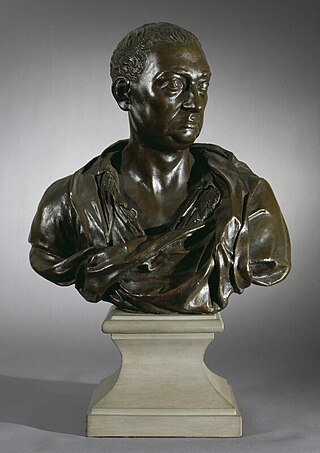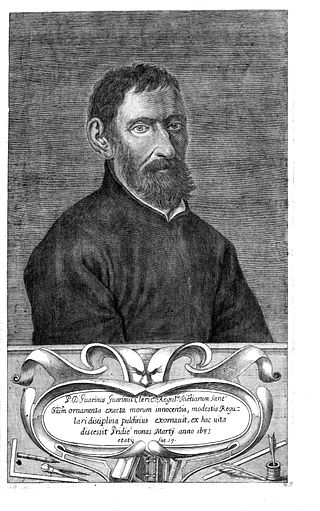This article relies largely or entirely on a single source .(March 2019) |
| |||
|---|---|---|---|
| Buildings and structures +... |
The year 1715 in architecture involved some significant events.
This article relies largely or entirely on a single source .(March 2019) |
| |||
|---|---|---|---|
| Buildings and structures +... |
The year 1715 in architecture involved some significant events.


Nicholas Hawksmoor was an English architect. He was a leading figure of the English Baroque style of architecture in the late-seventeenth and early-eighteenth centuries. Hawksmoor worked alongside the principal architects of the time, Christopher Wren and John Vanbrugh, and contributed to the design of some of the most notable buildings of the period, including St Paul's Cathedral, Wren's City of London churches, Greenwich Hospital, Blenheim Palace and Castle Howard. Part of his work has been correctly attributed to him only relatively recently, and his influence has reached several poets and authors of the twentieth century.

Baroque architecture is a highly decorative and theatrical style which appeared in Italy in the early 17th century and gradually spread across Europe. It was originally introduced by the Catholic Church, particularly by the Jesuits, as a means to combat the Reformation and the Protestant church with a new architecture that inspired surprise and awe. It reached its peak in the High Baroque (1625–1675), when it was used in churches and palaces in Italy, Spain, Portugal, France, Bavaria and Austria. In the Late Baroque period (1675–1750), it reached as far as Russia, the Ottoman Empire and the Spanish and Portuguese colonies in Latin America. In about 1730, an even more elaborately decorative variant called Rococo appeared and flourished in Central Europe.

Turin Cathedral is a Roman Catholic cathedral in Turin, northern Italy. Dedicated to Saint John the Baptist. It is the seat of the Archbishops of Turin.

The Teatro Regio is a prominent opera house and opera company in Turin, Piedmont, Italy. Its season runs from October to June with the presentation of eight or nine operas given from five to twelve performances of each.

Filippo Juvarra was an Italian architect, scenographer, engraver and goldsmith. He was active in a late-Baroque architecture style, working primarily in Italy, Spain, and Portugal.

Camillo Guarino Guarini was an Italian architect of the Piedmontese Baroque, active in Turin as well as Sicily, France and Portugal. He was a Theatine priest, mathematician, and writer. His work represents the ultimate achievement of Italian Baroque structural engineering, creating in stone what could be attempted today in reinforced concrete.
Events concerning Architecture from the year 1736.

The Palazzina di caccia of Stupinigi is one of the Residences of the Royal House of Savoy in the Metropolitan City of Turin in northern Italy, part of the UNESCO World Heritage Sites list. Built as a royal hunting lodge in the early 18th century, it is located in Stupinigi, a suburb of the town of Nichelino, 10 km (6 mi) southwest of Turin.

Palazzo Madama e Casaforte degli Acaja is a palace in Turin, Piedmont. It was the first Senate of the Kingdom of Italy, and takes its traditional name from the embellishments it received under two queens (madama) of the House of Savoy.

The Basilica of Superga is a hilltop Catholic basilica in Superga, in the vicinity of Turin, Italy.

Bernardo Antonio Vittone was an Italian architect and writer. He was one of the three most important Baroque architects active in the Piedmont region of Northern Italy; the other two were Filippo Juvarra and Guarino Guarini. The youngest of the three, Vittone was the only one who was born in Piedmont. He achieved a synthesis of the spatial inventiveness of Juvarra and the engineering ingenuity of Guarini, particularly in the design of his churches, the buildings for which he is best known.
The year 1718 in architecture involved some significant events.

The Palace of Venaria is a former royal residence and gardens located in Venaria Reale, near the city of Turin in the Piedmont region in northern Italy. It is one of the 14 Residences of the Royal House of Savoy built in the area between the 16th and 18th centuries which were collectively designated a UNESCO World Heritage Site in 1997.
Amedeo Cognengo di Castellamonte was an Italian architect, civil and military engineer.

Italian Baroque architecture refers to Baroque architecture in Italy.

San Filippo Neri is a late-Baroque style, Roman Catholic church located in Turin, region of Piedmont, Italy. The church is located on Via Maria Vittoria 5; the left flank of the nave faces the Turin Academy of Sciences. The church is still used for services. 69 metres (226 ft) long and 37 metres (121 ft) wide, it is the largest church in the city of Turin.

San Martino Vescovo di Tours is a Roman Catholic parish church, located in Albiano d'Ivrea in the Metropolitan City of Turin, region of Piedmont, northern Italy.

The Project of Filippo Juvarra for the Royal Palace of Madrid was the first project for the Royal Palace of Madrid.